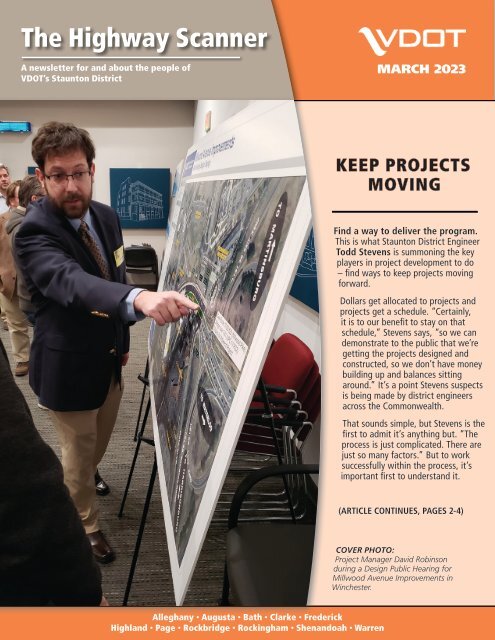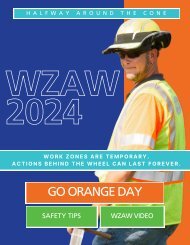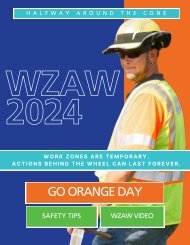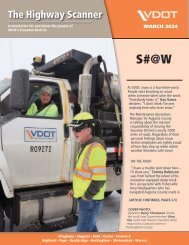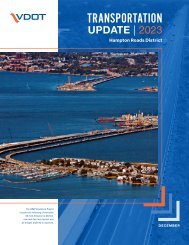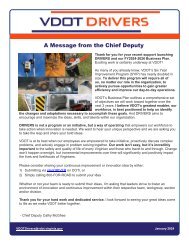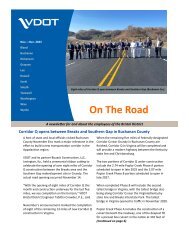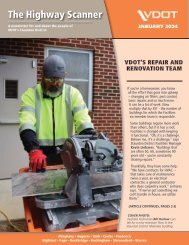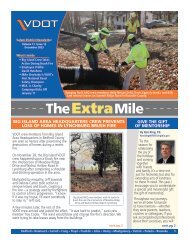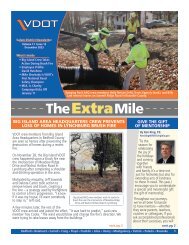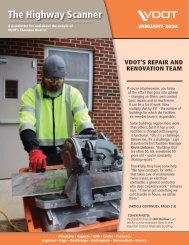Staunton District - Highway Scanner - March 2023
You also want an ePaper? Increase the reach of your titles
YUMPU automatically turns print PDFs into web optimized ePapers that Google loves.
The <strong>Highway</strong> <strong>Scanner</strong><br />
A newsletter for and about the people of<br />
VDOT’s <strong>Staunton</strong> <strong>District</strong><br />
MARCH <strong>2023</strong><br />
KEEP PROJECTS<br />
MOVING<br />
Find a way to deliver the program.<br />
This is what <strong>Staunton</strong> <strong>District</strong> Engineer<br />
Todd Stevens is summoning the key<br />
players in project development to do<br />
– find ways to keep projects moving<br />
forward.<br />
Dollars get allocated to projects and<br />
projects get a schedule. “Certainly,<br />
it is to our benefit to stay on that<br />
schedule,” Stevens says, “so we can<br />
demonstrate to the public that we’re<br />
getting the projects designed and<br />
constructed, so we don’t have money<br />
building up and balances sitting<br />
around.” It’s a point Stevens suspects<br />
is being made by district engineers<br />
across the Commonwealth.<br />
That sounds simple, but Stevens is the<br />
first to admit it’s anything but. “The<br />
process is just complicated. There are<br />
just so many factors.” But to work<br />
successfully within the process, it’s<br />
important first to understand it.<br />
(ARTICLE CONTINUES, PAGES 2-4)<br />
COVER PHOTO:<br />
Project Manager David Robinson<br />
during a Design Public Hearing for<br />
Millwood Avenue Improvements in<br />
Winchester.<br />
Alleghany • Augusta • Bath • Clarke • Frederick<br />
Highland • Page • Rockbridge • Rockingham • Shenandoah • Warren
PROJECT DEVELOPMENT<br />
THE PROCESS<br />
A project is initiated when it’s assigned to a project manager. Funding is established<br />
and the scope is generally defined. There are several major milestones in the<br />
development process: Scoping, Preliminary Design, Public Outreach, Detailed Design,<br />
Final Design, Right of Way activities, and Advertising for Construction. Each phase<br />
has its own set of tasks and legal requirements.<br />
During Scoping, the project gets more specific – determining how long it’s going to<br />
take to get to advertisement and how much it’s really going to cost.<br />
It begins with Survey, which involves a detailed process of locating objects out in<br />
the field such as pipes, bridges, and rivers, and taking 3D measurements. This can<br />
require aerial photos that can only be captured when the trees are leafless.<br />
Environmental’s efforts, like many of the district’s other sections, are sprinkled<br />
throughout project development. “Documents and permits for federal projects are<br />
the two biggest things we do,” says Environmental Manager Liz Jordan. They begin<br />
their review process in Scoping. The team identifies natural resources, hazardous<br />
materials, and cultural resources. “That’s a big one for us,” Jordan imparts. “Typically,<br />
we’re trying to minimize our impacts to any historic property.” Project designers<br />
are skilled at this, but Jordan says impacts can be unavoidable and require a lot of<br />
consulting and time to reach an agreement.<br />
This process extends into Preliminary Design where the Environmental Section chips<br />
away at one of its biggest rocks - drafting the National Environmental Policy Act<br />
(NEPA) document which is to be completed prior to public hearing. It demonstrates<br />
that VDOT has complied with all applicable federal and state laws, regulations, and<br />
executive orders, in consultation with the appropriate stakeholders.<br />
A big part of Preliminary Design involves engineering. For smaller projects, that can<br />
be done in house by the project managers themselves. But for larger projects, such<br />
as interstate widening in the I-81 Corridor Improvement Program, VDOT works with<br />
consultant engineers. Project managers review those plans and work to keep the<br />
budget in check.<br />
TOP RIGHT: Project Manager Jennifer<br />
Hoover.<br />
BOTTOM RIGHT: Survey Tech Jonathan<br />
Marquise.<br />
TOP LEFT: <strong>District</strong> Construction Engineer<br />
Robbie Good.<br />
BOTTOM LEFT: Edinburg Assistant<br />
Resident Engineer Matt Smith, L&D<br />
Manager Scott Alexander, and Edinburg<br />
Residency Land Use Engineer Joe Johnson<br />
during a public hearing in Winchester.<br />
This phase is also a time when Construction weighs in. “The project managers carry the<br />
torch and do all the work,” <strong>District</strong> Construction Engineer Robbie Good points out,<br />
but it’s important for Construction to review plans and point out potential concerns.<br />
“If we see something that could be a problem we are having those discussions,<br />
identifying and assigning the risk, and best figuring out how to address it.”<br />
Once Preliminary Design is complete, it’s time for Public Involvement, often in the<br />
form of a public hearing. Matt Dana, Assistant <strong>District</strong> Administrator for Preliminary<br />
Engineering, Planning and Investment, enjoys this phase. “I like working with the<br />
public and helping them understand why we’re doing what we do,” he says. “I don’t<br />
think they realize the complexity of a project. It’s really complicated and we have a<br />
lot of projects.” Some are more controversial, requiring enhanced public involvement.<br />
Project managers and engineers consider comments from the public and finalize<br />
plans during the Detailed Design phase. This leads to the major milestone of Design<br />
Approval and the beginning of Right of Way acquisition – the final stage before<br />
Advertising for construction. “Getting right of way is often the hardest step,” Project<br />
Manager Jennifer Hoover explains. <strong>District</strong> Location and Design Engineer John-<br />
Allen Ennis adds, “That adds a lot of time when we have to acquire right of way.”<br />
The Right of Way division also tackles utility relocations, but the biggest challenge<br />
is acquiring property. Regional Right of Way Manager Mike Sprouse says the goal<br />
Continued on next page<br />
2<br />
MARCH <strong>2023</strong>
PROJECT DEVELOPMENT<br />
is getting everybody to say ‘yes’. “You’d be amazed at some of the negotiations we<br />
get into,” Sprouse reveals. “Sometimes it’s money, but sometimes it’s something the<br />
owner wants.”<br />
Another time-consuming process is relocating people and businesses. “If we have<br />
a relocation, we almost always ask for 18 months, because the process just takes<br />
so long and the market is so volatile.” Sometimes, despite every effort, Sprouse<br />
says they reach an impasse and eminent domain enters the conversation. “We try<br />
everything we can to avoid that.”<br />
The final phase of project development is advertising the project for construction.<br />
This is where the baton is passed to Construction – where project development ends<br />
and delivery begins.<br />
ABOVE: Regional Right of Way Manager<br />
Mike Sprouse.<br />
A HEAVY LOAD<br />
Leading project development are the project managers, who juggle a number of projects at once. “Our group alone administers<br />
around 60-some projects at a time that we’re managing and designing,” Ennis states. The Bridge group typically has another 15 or<br />
16 projects under development, and Location and Design does a lot of design work on many of those as well. “Project managers<br />
have to work very closely with all of the other sections,” Ennis says. “We have to have a little bit of knowledge about what each<br />
group does.”<br />
Approaching four years as a project manager, David Robinson now has a clear understanding of his role. “At first I thought<br />
‘Oh, I’m project manager. I’ve got these jobs that I need to work with my team to get stuff done,’” he says. “I manage a project<br />
but I don’t manage people, I coordinate. But the project is mine and I just have to get it across the finish line.”<br />
Robinson describes it as making sure he’s checking all the boxes on all the checklists. Hoover adds, “Each category has its own set<br />
of tasks. They’re consistent. A lot of tasks go on at the same time, but if one is on the critical path, you can't start the next task<br />
until the previous one is complete.”<br />
“The process is a flow chart, and there’s a 150-page manual that goes with it,” Robinson<br />
shares. “It tells you what to do, but not who to talk to.” There are numerous people and<br />
several departments that can play a part in project development beyond Location and<br />
Design, Survey, Environmental, Construction, and Right of Way. Materials conducts soil<br />
tests to determine what’s underground, Traffic Engineering is responsible for signals<br />
and traffic flow, Civil Rights and Communications oversee public involvement, and<br />
Structure and Bridge is often central to the design process, not to mention consultants<br />
and external stakeholders like localities and the public at large.<br />
“Everybody sees their piece of the overall project differently,” Location and Design<br />
Manager Scott Alexander conveys, and this can cause competing priorities. “Usually<br />
if there’s a dissenting opinion or whatever the case may be, it’s a matter of making sure<br />
you understand what the issue is.”<br />
Dana says project managers have perhaps the most difficult job in VDOT. “They’re<br />
trying to move these projects through the process and the people who are working<br />
with them don’t work for them, so they don’t have any authority over those folks. It’s<br />
really a challenging position to be in.”<br />
TOP LEFT: Pre-Advertisement Conference for I-81<br />
auxiliary lane project (mile marker 221-220).<br />
BOTTOM LEFT: Project Manager Jennifer Hoover.<br />
BOTTOM CENTER: Environmental Specialist Katelyn<br />
Shiflett and Environmental Manager Liz Jordan.<br />
BOTTOM RIGHT: Assistant D.A. for Preliminary<br />
Engineering, Planning and Investment Matt Dana.<br />
Continued on next page<br />
MARCH <strong>2023</strong> 3
PROJECT DEVELOPMENT<br />
SMART SCALE<br />
Another challenge is a byproduct of the SMART SCALE system for prioritizing transportation improvements. Technically SMART<br />
SCALE is pre-project development, but it plays a critical role throughout the process. “The way we fund and deliver projects is<br />
inherently different now that SMART SCALE exists,” <strong>District</strong> Planner Brad Reed conveys. Before SMART SCALE, localities put an<br />
idea forward without a study or the details worked out. Now projects are selected with a fixed schedule, and the cost estimate<br />
becomes the budget.<br />
“The challenge is having all the information when you have no information,” Dana says. “We have to have more accurate<br />
estimates at very early stages like the SMART SCALE application phase, because you don’t want to come back three years later<br />
and say ‘Well, we really need another $5 million.’ That doesn’t typically go over very well.”<br />
“You’re usually looking at three years into VDOT’s Six-Year Improvement Program to begin design on a SMART SCALE project,”<br />
Reed explains. Depending on the size and complexity of the project, it can take several more years to go through development<br />
and delivery. In the meantime, the clock is ticking and the cost of doing business continues to rise. “Inflation is unforeseen and<br />
really adds up,” Robinson points out, “especially when you’re dealing with tens of millions of dollars.” This leaves the project<br />
development team with a choice: Ask for more money or change the scope, which extends the project even further.<br />
THE DASHBOARD AND BEYOND<br />
There is a system that measures project delivery – the VDOT Dashboard. It offers<br />
a quick glance at the performance of Virginia’s transportation system. In addition<br />
to highway safety, the condition of roads and bridges, and interstate clearance<br />
times, the dashboard measures if projects are on time and on budget.<br />
Stevens says VDOT Dashboard is an excellent tool for measuring performance, but<br />
he says it’s important not to lose sight of the mission, which is to effectively and<br />
efficiently develop projects to advertisement. “As managers, we need to get our<br />
arms around closing the scoping activity so we are truly developing projects as<br />
quickly as possible and meeting the Dashboard targets,” Stevens says. “Project<br />
development is a team effort and I have confidence we will find ways to be<br />
successful regardless of the circumstances.” •<br />
TOP RIGHT: <strong>District</strong> Planner Brad Reed.<br />
MIDDLE RIGHT: <strong>District</strong> L&D Engineer John-Allen Ennis.<br />
BOTTOM RIGHT: NPDES Coordinator/Environmental Commitments<br />
Inspector Will Hamblet.<br />
BOTTOM LEFT: Design Public Hearing for Millwood Avenue<br />
Improvements in Winchester.<br />
44<br />
SEPTEMBER MARCH <strong>2023</strong> 2020
FOCUS ON SAFETY<br />
3 New Safety Directives for ALL VDOT Employees<br />
1 – Vehicle Backing and Parking<br />
√ Driver/Operator shall complete Safety Circle Walk EVERY TIME before driving<br />
√ Use spotter if available – STOP IMMEDIATIELY if lose sight of spotter.<br />
√ Backing should be kept to minimum – use pull-through parking when possible.<br />
√ Back slowly, staying in contact with spotter and repeatedly checking mirrors.<br />
2 – Occupant Restraints<br />
√ VDOT employees and contract employees on official VDOT business MUST wear seat belts while operating or riding<br />
in vehicles/equipment.<br />
√ If vehicle/equipment is in motion, seatbelt MUST be worn<br />
3 – Headlights on Safety<br />
√ All VDOT owned, leased or rented vehicles and equipment, and all personal vehicles used for VDOT business, shall<br />
be operated with front lights running during daytime.<br />
√ Some vehicles have automatic running lights. Those that don’t, shall have low beam headlights manually turned on.<br />
√ When weather causes reduced visibility, vehicles with automatic running lights need to be switched to low beam<br />
headlights.<br />
Safety Circle Walk – Get Out and Look<br />
√ Walk around vehicle completely and survey<br />
backing area<br />
√ Check for overhead clearance<br />
√ Check ground for softness and hidden hazards<br />
√ Position mirrors properly<br />
√ Back towards driver’s side when possible to<br />
reduce blind spots<br />
√ When backing toward fixed object, consider<br />
prepositioning tire chocks at estimated<br />
stopping point<br />
√ Back in slowly<br />
SPOTTER HAND SIGNALS<br />
5<br />
MARCH MARCH <strong>2023</strong> <strong>2023</strong><br />
5
FOCUS FOCUS ON ON SAFETY SAFETY<br />
2022 Gold Star Safety Award<br />
<strong>Staunton</strong> Traffic Maintenance Pavement Markings & Signs<br />
<strong>Staunton</strong><br />
Always<br />
For<br />
Excellence<br />
Five Star Award Winners<br />
Facility Inspections * Pre-Operation Inspections *<br />
No Preventable Crashes or Incidents * No Recordable Injuries<br />
» Survey Section<br />
» Pavement Markings & Signs<br />
» Verona Bridge Crew<br />
» Lexington Bridge Crew<br />
» Harrisonburg Bridge Crew<br />
» Luray Bridge Crew<br />
» Edinburg Bridge Crew<br />
» Luray AHQ<br />
» Roadside<br />
» Materials<br />
» Winchester Shop<br />
» Harrisonburg Shop<br />
Monthly Safety Report January <strong>2023</strong><br />
<strong>Staunton</strong> <strong>District</strong><br />
Data Last Refreshed<br />
Feb 21, <strong>2023</strong> 07:53:44 AM<br />
<br />
<strong>District</strong> Name<br />
<strong>Staunton</strong> <strong>District</strong><br />
Edinburg Residency Wide<br />
Harrisonburg Residency Wide<br />
Lexington Residency Wide<br />
<strong>Staunton</strong> <strong>District</strong> Office<br />
Hours 12mo<br />
1,174,353.60<br />
211,927.00<br />
267,218.90<br />
188,474.20<br />
506,733.50<br />
OSHA Recordables<br />
Month<br />
1<br />
0<br />
1<br />
0<br />
0<br />
OSHA Recordables<br />
12mo<br />
9<br />
3<br />
4<br />
2<br />
0<br />
OSHA Recordable<br />
Rate 12mo<br />
1.53<br />
2.83<br />
2.99<br />
2.12<br />
0.00<br />
Lost Day Cases<br />
Month<br />
1<br />
0<br />
1<br />
0<br />
0<br />
Lost Day Cases<br />
12mo<br />
4<br />
1<br />
2<br />
1<br />
0<br />
Lost Day Case<br />
Rate 12mo<br />
Total 1,174,353.60 1 9 1.53 1 4 0.68 80<br />
0.68<br />
0.94<br />
1.50<br />
1.06<br />
0.00<br />
Lost Days<br />
12mo<br />
80<br />
26<br />
39<br />
15<br />
0<br />
OSHA Recordable Rate 12 Month Rolling Average<br />
Lost Days Rolling 12 Month Totals<br />
Total Injuries by Causes<br />
Residency Edinburg Resid… Harrisonbur… Lexington R… <strong>Staunton</strong> …<br />
Residency Edinburg Resid… Harrisonbur… Lexington Re… <strong>Staunton</strong> …<br />
OSHA Severity Non-Recordable Recordable<br />
6<br />
6.18 6.15<br />
5.36<br />
6.09<br />
5.34<br />
5.33<br />
4.55<br />
5.32<br />
5.28<br />
4.50<br />
4.43<br />
300<br />
328<br />
328<br />
327<br />
348<br />
Struck by/against<br />
Animal/insect<br />
Overexertion<br />
3<br />
2<br />
2<br />
8<br />
2<br />
1<br />
4<br />
2<br />
3.86 3.85<br />
3.33 3.34<br />
2.88 2.90 2.88<br />
2.79 2.83<br />
2.23 2.21 2.21 2.21 2.20 2.19 2.17 2.15 2.10 2.12<br />
1.93<br />
1.92 1.92 1.91 1.90<br />
200<br />
100<br />
150 150 150<br />
219 219 219 219 219 219 219<br />
Contact by/with 2 1<br />
0 5 10<br />
Injury by Work Task<br />
OSHA Severity Non-Recordable Recordable<br />
0<br />
0.78 0.78 0.78<br />
0.39<br />
February 2…<br />
<strong>March</strong> 2022<br />
April 2022<br />
May 2022<br />
June 2022<br />
0.39 0.39 0.39 0.40 0.40<br />
0.00 0.00 0.00<br />
July 2022<br />
August 2022<br />
September 2022<br />
October 2022<br />
November 2022<br />
December 2022<br />
January <strong>2023</strong><br />
0<br />
21<br />
0<br />
21<br />
0<br />
February 2…<br />
<strong>March</strong> 2022<br />
April 2022<br />
21<br />
0<br />
26 26 26 26 26 26 26 26<br />
0 0 0 0 0 0 0 0<br />
May 2022<br />
June 2022<br />
July 2022<br />
August 2022<br />
September 2022<br />
October 2022<br />
November 2022<br />
December 2022<br />
January <strong>2023</strong><br />
39<br />
26<br />
0<br />
Brush removal<br />
4<br />
1<br />
Ditching/shoulder operations<br />
Tree felling and limbing<br />
2<br />
2<br />
1<br />
1<br />
Entering/exiting 1 1<br />
0 5<br />
66<br />
MARCH JULY 2020 <strong>2023</strong>
NEWS & NOTES<br />
"READING" ROADS FOR THE RIGHT RESPONSE<br />
“The guys in our area headquarters know their roads. They know their cold spots,”<br />
<strong>District</strong> Maintenance Engineer Joel DeNunzio proudly states. This winter, the <strong>Staunton</strong><br />
<strong>District</strong> is piloting a program that offers another way to verify or find those cold spots. It<br />
has the potential to save VDOT time, money and effort.<br />
It’s a mobile RWIS (Road Weather Information System) and <strong>Staunton</strong>’s maintenance<br />
department is leasing six of them. Just like the stationary units scattered throughout the<br />
district, the mobile unit measures pavement temperatures, road conditions and friction<br />
factors, but takes it on the road. “We can drive a section of road and analyze that whole<br />
road,” DeNunzio says. The mobile RWIS attaches on the outside of vehicles and links to<br />
a phone inside the vehicle, which captures pictures through the windshield. The mobile<br />
RWIS collects the data which is accessible both on the road and back at the district,<br />
allowing VDOT to respond quickly.<br />
DeNunzio says the data is key. “If we don’t know what we’re dealing with and we put a<br />
layer of salt down, but the pavement is too cold for the salt to really do anything, then all<br />
we’re doing is scraping the salt off the road.<br />
He admits it’s a little tough to gauge the value of the mobile RWIS during a mild winter like<br />
this, but DeNunzio says other states using them are seeing a huge benefit. “They’re finding<br />
huge savings in salt,” he says. “That’s not only a money savings, it’s an effort savings and<br />
environmental savings also.”<br />
DeNunzio remains hopeful. “What’s important is how we treat the roads to get them cleared,<br />
and we can choose a better treatment option when we understand where our cold spots are,<br />
what our pavement temperatures are, and where we’re seeing conditions.”<br />
Moving Forward – Focus on Innovation<br />
I-81 CORRIDOR IMPROVEMENT UPDATE<br />
Construction is expected to begin later this year on two large I-81 CIP projects in<br />
Augusta County. But there’s plenty of work already taking place along the interstate<br />
and adjacent primary routes.<br />
In early April VDOT is scheduled to execute a design-build contract for widening<br />
I-81 in the <strong>Staunton</strong> area. Construction should start soon after, and be complete in<br />
summer 2027. The roughly $172 million project will add a third lane northbound<br />
and southbound between exit 221 (the junction with I-64) and exit 225 (Route 262<br />
on the northern end of <strong>Staunton</strong>).<br />
An adjacent project adds a southbound auxiliary lane between exit 221 and exit<br />
220 (the southern end of Route 262). VDOT is set to advertise the $14 million<br />
project in July, and construction should start by the end of the year. A major part of<br />
this project is replacement of the Route 635 (Barterbrook Road) overpass bridge.<br />
Geotechnical work such as core-sample drilling (photo at left) and groundpenetrating<br />
radar has been taking place along I-81 in the Weyers Cave and<br />
Harrisonburg areas. These operations are part of the preliminary engineering for<br />
truck climbing lanes near the Augusta-Rockingham county line, and interstate<br />
widening through Harrisonburg. These projects are scheduled to go under<br />
construction in 2024 and 2025.<br />
The I-81 CIP includes numerous improvements near interchanges and along key parallel roads such as Route 11 and<br />
Route 37. Upgrades include traffic cameras, digital message signs, and enhanced coordination among traffic signals.<br />
Contractors are working at about a dozen different locations including Winchester, Mount Crawford and Verona.<br />
MARCH <strong>2023</strong> 7
NEWS & NOTES<br />
"PROVEN TRACK RECORD" IN CONSTRUCTION<br />
<strong>Staunton</strong> VDOT has a new <strong>District</strong> Construction Engineer – Robbie Good. He assumed the role at the end of February.<br />
The Luray-native comes to the role with his professional engineer license and more than 25 years of experience in<br />
construction and engineering. Good says he’s both grateful and excited for the opportunity.<br />
Good joined VDOT in 1996 as an hourly inspector trainee. Four years later and with a B.S. in Civil Engineering from<br />
Virginia Tech, Good participated in the engineer development program and was promoted to project manager. Good<br />
worked in the private sector for a few years, but found his way back to the department in 2006 as a construction<br />
manager, and then as area construction engineer for the northern part of the district. In that role, Good administered<br />
over 220 contracts with a combined value exceeding $500 million.<br />
“Robbie has administered a wide range of projects with varying scope<br />
and complexity,” <strong>Staunton</strong> <strong>District</strong> Engineer Todd Stevens says. “He has<br />
a proven track record in delivering quality projects safely, on time and on<br />
budget.”<br />
For Good VDOT is more than a place to work, it’s a legacy. “My greatgrandfather<br />
retired from the Department of <strong>Highway</strong>s. My grandfather<br />
and father also worked for VDOT,” Good shares. “This foundation for<br />
service, coupled with the mentors and peers that I have learned from and<br />
worked with over the years has led me to this point. I am grateful for their<br />
support and all of the relationships built along the way.”<br />
Good intends to support Materials, Contract Administration and<br />
Construction staff to make sure they have what they need to be successful.<br />
He also plans to develop relationships with the contracting and consulting<br />
industry. “Those partnerships will be critical to our success as all of this<br />
work, especially along the I-81 Corridor, begins to unfold,” Good says.<br />
DETERMINATION LEADS TO SUCCESS<br />
<strong>Staunton</strong> <strong>District</strong> Equipment Repair Manager Joe Hildebrand is the only VDOT shop manager in the state with the<br />
distinguished honor of being an AEMP Certified Equipment Manager. AEMP is the Association of Equipment Management<br />
Professionals, and the industry standard for those who manage and maintain heavy equipment.<br />
When Hildebrand heard the news, he called his wife. “She was excited. She was tickled pink,” Hildebrand shares. “First<br />
thing she said was ‘Thank God’.” For roughly a year, after days spent overseeing equipment repairs on anything from<br />
chainsaws to motor graders in the <strong>Staunton</strong> <strong>District</strong> shop, Hildebrand would often head home to spend hours at night<br />
studying.<br />
<strong>Staunton</strong> <strong>District</strong> Equipment Manager L.T. Williams recommended Hildebrand for the program. “That is a great<br />
accomplishment,” Williams says, and he would know. He earned his certificate more than 20 years ago, but recalls the<br />
experience like it was yesterday. “It’s a hard test,” Williams laments. “I remember exactly how it was.”<br />
Hildebrand’s more than two decades of experience as a technician,<br />
with four at VDOT as shop manager, helped prepare him for the<br />
challenge. It involved a points-based application process, an eightweek<br />
learning lab and a 150-question test which Hildebrand used<br />
every bit of the allotted four hours to complete. Hildebrand describes<br />
the accomplishment as feeling like he’s on cloud 9.<br />
LEFT: <strong>District</strong> Equipment Repair<br />
Manager Joe Hildebrand.<br />
CENTER: <strong>District</strong> Equipment<br />
Manager L.T. Williams.<br />
8<br />
SEPTEMBER MARCH <strong>2023</strong> 2020
NEWS & NOTES<br />
A CLOSE CALL<br />
On the afternoon of November 22, Operator Robbie Hutton was on his way back to the<br />
Winchester Area Headquarters after a day of grading on Knob Road. Hutton describes<br />
this part of Frederick County as mountainous and heavily wooded. “Along the way I saw<br />
smoke rising above the tree line,” Hutton recalls.<br />
The closer he got to 760 Knob Road, the heavier the smoke. “Something just didn’t seem<br />
right,” Hutton recounts. He decided to stop and see what was going on. “As I walked up<br />
the driveway and crested the top of the hill, that’s when I saw a large part of the yard close<br />
to a house was on fire,” Hutton says.<br />
Hutton called out and no one answered. He realized the fire was spreading toward<br />
the house and garage. Despite his trepidation about being on private property, Hutton<br />
responded. He called 911 and grabbed a rake off the grader. “I went back to the fire<br />
line and raked out the fire closest to the house.” Then, Hutton ran to the front door and<br />
started banging. “An older gentleman answered the door,” Hutton remembers. The man<br />
had been napping. Hutton told him about the fire and the man safely exited the house.<br />
By the time Hutton got back to the fire, the garage had begun to melt. “I started raking<br />
the burning leaves away from the garage and beat out the spots on the siding that were<br />
on fire,” Hutton shared.<br />
Firefighters responded, and Hutton and Operator Morgan Kibler pulled hoses and did what they<br />
could to help crews successfully extinguish the fire.<br />
Winchester AHQ Superintendent Maury Sutphin was at the shop when the homeowner came in<br />
to thank Hutton. “He said he was thankful that Robbie had seen the fire and actually stopped the<br />
machine he was on and came onto his property,” Sutphin says. “We usually stay in our right of<br />
way working, but if we see something that we can help somebody with, we are a public service.”<br />
“Sometimes you have to step outside of your boundaries and normal everyday activities to help<br />
other people in times of need,” Hutton says, grateful he could be there to help. “Thankfully, the<br />
man’s property was saved and no one was hurt.”<br />
WORKFORCE TRAINING<br />
AND DEVELOPMENT<br />
Be sure to complete your online<br />
video training NOW for VDOT'S <strong>2023</strong><br />
Safety Excellence Award Program!<br />
Field Employee Training<br />
> Field Safety<br />
> Safety Reporting<br />
> VDOT Fire Extinguisher Training<br />
> Construction: Caught-in or Caught-between<br />
Office Employee Training<br />
> Office Safety<br />
> Safety Reporting<br />
> VDOT Fire Extinguisher Training<br />
> Active Shooter 2.0<br />
Visit the VDOT-U website to get started<br />
WELCOME TO VDOT!<br />
January and February <strong>2023</strong><br />
New Hires / Rehires<br />
Bradford Allen, TO II, Winchester<br />
Doug Holt, AE I, NWRO<br />
Shanon Sprinkle, TO II, Mauzy<br />
Wendy Webber, AOS III, Winchester<br />
Virgil Dedrick, TO II, <strong>Staunton</strong><br />
Thomas Fitzgerald, TO II, Verona<br />
Dylan Lake, TO II, Stephens City<br />
Kuang-Yuan Hou, A/E I, <strong>Staunton</strong><br />
William Housman, Env Specialist II, <strong>Staunton</strong><br />
Contact Chris Testerman (540) 480-8900<br />
or Janice Ramsey (540) 332-8934<br />
if you need help or have questions.<br />
Due to changes in reporting methods, Service Award listings will resume in the next <strong>Highway</strong> <strong>Scanner</strong>.<br />
SEPTEMBER MARCH <strong>2023</strong> 2020 9
AROUND THE DISTRICT A MESSAGE FROM TODD STEVENS ...<br />
Just about everything we do in the VDOT <strong>Staunton</strong> <strong>District</strong><br />
requires a team approach – from working safely in the field<br />
to meeting prompt-pay benchmarks in our Business office.<br />
Technician Jack Borden (center) beat<br />
out 240 other technicians to win the<br />
2022 VDOT Technician of the Year<br />
award. <strong>District</strong> Equipment Manager L.T.<br />
Williams (left) and State Equipment<br />
Manager Brian Marshall (right) helped<br />
recognize Borden on January 24.<br />
One of our most critical team efforts involves project<br />
development and delivery. Hundreds of VDOTers continually<br />
work together to take each new project from concept to<br />
construction. Even a relatively simple project like a repaving<br />
job or an intersection improvement involves employees from<br />
several different sections. This collaboration is even more<br />
obvious, and more intensive, on major construction like a<br />
new roadway or a large bridge replacement.<br />
Our agency’s annual construction budget is more than $3 billion dollars. This financial<br />
commitment shows that taxpayers and elected leaders have a high level of trust in us.<br />
They trust VDOT to work diligently and wisely to bring new projects to completion, and<br />
our district team never forgets that. I strongly encourage you to read the cover article<br />
in this edition of The <strong>Highway</strong> <strong>Scanner</strong> to find out how your teammates earn that trust.<br />
A monthly Program meeting brings together roadway and bridge design engineers,<br />
environmental and materials specialists, traffic engineers, and representatives from our<br />
residencies and right of way sections. Line by line they review projects in the development<br />
phases and share strategies for accelerating their paths to construction.<br />
The VDOT <strong>Staunton</strong> <strong>District</strong> delivered<br />
130 hygiene bags to the Valley<br />
Mission in <strong>Staunton</strong> February 2.<br />
Civil Rights organized the collection<br />
for the Martin Luther King Jr. Day of<br />
Service. THANK YOU everyone for all<br />
the donations. Pictured left to right:<br />
Civil Rights Specialist Melissa Lotts,<br />
Civil Rights Manager Carolyn Sharp,<br />
<strong>District</strong> Engineer Todd Stevens,<br />
Valley Misson representative.<br />
Of course, team members don’t wait for official monthly meetings to collaborate and<br />
brainstorm. Each of them is partly responsible for getting projects to the finish line. And<br />
each of those projects is more than what they can see on paper or a computer screen.<br />
They have been carefully chosen because they will more efficiently move traffic, enhance<br />
safety for motorists, or protect Virginians’ investment in their transportation system.<br />
There’s one more team effort I want to address: the three new safety directives for all<br />
VDOT employees. The directives, which took effect February 1, address vehicle backing<br />
and parking as well as seat-belt and headlight usage.<br />
Backing incidents remain an all-too-common cause of employee injuries and equipment<br />
damage. One of the new initiatives establishes the “Safety Circle Walk” to identify<br />
potential hazards or obstructions before moving a vehicle or piece of equipment. It also<br />
includes an eye-opening video about the blind spots surrounding VDOT dump trucks.<br />
The second directive is simple – buckle up, no matter what vehicle you’re driving or riding<br />
in. Follow this rule even on the shortest trips, such as those between the fuel island and<br />
your parking space.<br />
In honor of MLK Day, the Harrisonburg<br />
Residency and Verona Sub-Residency<br />
volunteered at the Blue Ridge Area<br />
Food Bank February 3. The team of 11<br />
spent 3 hours unpacking boxes of sweet<br />
potatoes and apples and repacking<br />
them into 5-pound bags for the BRAFB<br />
to give out to people in need.<br />
The final directive requires all VDOT vehicle operators to use headlights or daytime<br />
running lights, no matter the weather or time of day. If you’re more visible, you’re less<br />
likely to be in a crash.<br />
Each of us is responsible for becoming familiar with the new directives and putting them<br />
into practice. They take only a few extra seconds but could save a life.<br />
Todd Stevens, P.E.<br />
<strong>Staunton</strong> <strong>District</strong> Engineer<br />
<strong>Staunton</strong> <strong>District</strong> Office of Communications<br />
811 Commerce Road, <strong>Staunton</strong>, VA 24401-9029<br />
© <strong>2023</strong> Commonwealth of Virginia


